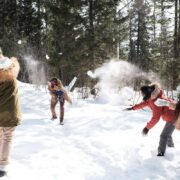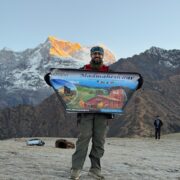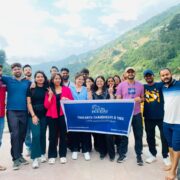
Chopta Tungnath and Chandrashila Trek From Delhi
Introduction: Your Himalayan Escape
Chopta Tour Package: Escape the hustle and bustle of city life and immerse yourself in the serene beauty of the Himalayas with the Chopta Tungnath Chandrashila trek. This captivating journey takes you through verdant meadows, alongside ancient temples, and culminates in breathtaking panoramic vistas, offering a truly unforgettable experience. For those seeking a rejuvenating break amidst nature’s grandeur, this trek, easily accessible from Delhi, presents an ideal opportunity to reconnect with tranquility and witness the majestic peaks up close.
The Allure of Chopta Tungnath Chandrashila: This trek is a symphony of natural and spiritual wonders. Your adventure begins in Chopta, often lovingly referred to as the “Mini Switzerland of India.” Imagine rolling hills carpeted in lush meadows, a vibrant tapestry of green stretching as far as the eye can see. As you ascend, the air grows crisper, and the views become increasingly dramatic, leading you towards Tungnath. Here, perched at an impressive altitude, stands the ancient Tungnath temple, the highest Shiva temple in the world. Its spiritual aura and historical significance add a unique dimension to your journey. Finally, the trek culminates at Chandrashila peak, where you are rewarded with awe-inspiring panoramic views of some of the most prominent Himalayan giants, including Nanda Devi, Trishul, and Chaukhamba. The sheer scale and beauty of the snow-capped peaks against the vast blue sky are truly mesmerizing.
Why This Trek? The popularity of the Chopta Tungnath trek stems from a confluence of compelling reasons. Firstly, it strikes a perfect balance in terms of difficulty. Classified as a moderate trek, it offers a satisfying challenge for both novice trekkers seeking their first Himalayan adventure and seasoned hikers looking for a shorter yet rewarding expedition. Secondly, the stunning scenery is a constant companion throughout the journey. Every season paints a different yet equally captivating picture from the vibrant rhododendron forests in spring to the clear, crisp views of autumn. Thirdly, the trek holds significant religious significance due to the presence of the sacred Tungnath temple, attracting devotees and spiritual seekers alike. Finally, its accessibility from Delhi makes it a convenient escape for those residing in and around the capital. Numerous Chopta tour package options cater to various budgets and preferences, simplifying the planning process and making this Himalayan gem easily reachable.
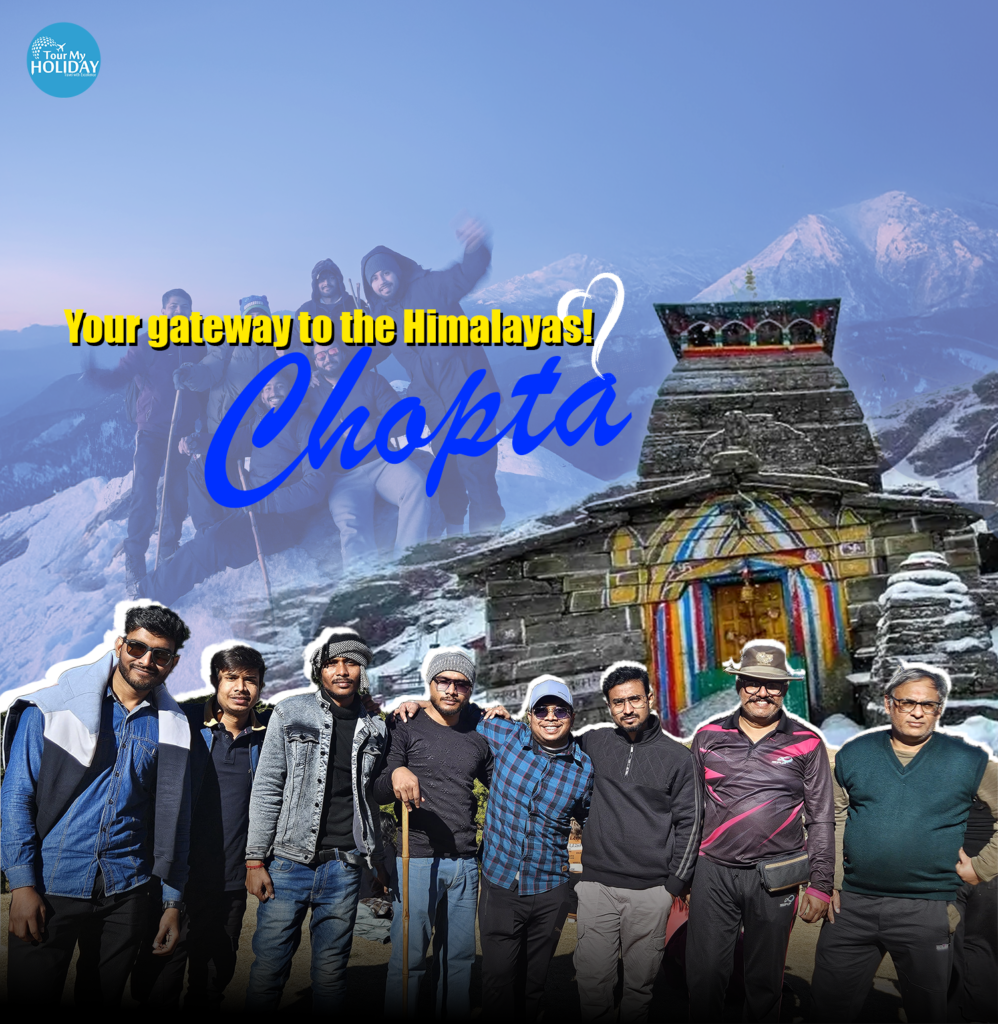
Who is This Trek For? The beauty of the Chopta Tungnath Chandrashila trek lies in its broad appeal. Beginners with a reasonable level of fitness will find the gradual ascent manageable and the rewards immensely gratifying. Experienced trekkers will appreciate the well-defined trails, the challenging climb to Chandrashila, and the unparalleled views. Nature lovers will be in their element, surrounded by diverse flora and fauna, crisp mountain air, and breathtaking landscapes. And for spiritual seekers, visiting the ancient Tungnath temple offers a profound sense of peace and connection. Whether you are looking for an adventurous escape, a spiritual sojourn, or simply a chance to immerse yourself in the lap of nature, the Chopta Tungnath trek, often included in a comprehensive Chopta tour package, promises an enriching and unforgettable Himalayan experience.
Planning Your Trip from Delhi
Planning a Chopta Chandrashila trek from Delhi requires careful consideration of various factors. Here’s a breakdown to help you organize your journey:
Best Time to Visit:
- Spring (March-May): This is arguably the most popular time to visit, with pleasant weather, blooming flowers, and clear skies. However, it can also be crowded.
- Summer (June-August): While the weather remains pleasant, expect occasional rainfall and leeches. The views are spectacular, but some trails might be muddy.
- Autumn (September-November): The weather is cool and dry, with stunning autumn foliage. However, some parts of the trail might be snow-covered.
- Winter (December-February): The trek is generally closed during this time due to heavy snowfall.
Duration of the Trek:
The typical duration of the Chopta Tungnath trek is 3-4 days, including travel time from Delhi. This allows for a leisurely pace and ample time to explore the surrounding areas.
Budgeting Your Trip:
The cost of the trek will vary depending on your travel style, accommodation choices, and whether you opt for a guided tour or travel independently. Here’s a rough breakdown of potential expenses:
- Transportation:
- Flight/Train to Delhi: Varies depending on your origin.
- Delhi to Chopta: Shared taxi/bus (around Rs. 2000-3000 per person), private car (around Rs. 8000-10000).
- Accommodation:
- Budget: Guesthouses/homestays (Rs. 500-1000 per night).
- Mid-range: Comfortable hotels/resorts (Rs. 1500-3000 per night).
- Food:
- Budget: Rs. 500-800 per day.
- Mid-range: Rs. 1000-1500 per day.
- Permits and Fees:
- Entry fees for national parks/wildlife sanctuaries.
- Porter/guide fees (optional).
- Other Expenses:
- Travel insurance, personal gear, souvenirs.

How to Reach Chopta from Delhi:
- By Road: The most common way to reach Chopta is by road. You can either drive yourself or hire a taxi. The journey is scenic but can be long and winding. The road conditions can vary depending on the season.
- By Bus: Overnight buses are available from Delhi to Rishikesh or Haridwar. From there, you can hire a taxi or take a local bus to Chopta.
- By Train: You can take a train to Haridwar or Rishikesh and then continue your journey by road.
Permits and Registrations:
No specific permits are generally required for the Chopta Chandrashila trek. However, it’s always advisable to check with local authorities for any updates or regulations.
Remember, these are just estimates, and the actual costs may vary depending on your travel style and preferences. By planning and budgeting carefully, you can ensure a smooth and enjoyable Chopta Tungnath trek from Delhi.
The Trekking Experience: A Journey Through Beauty and Spirituality
The Chopta Chandrashila trek is more than just a hike; it’s an immersive experience that tantalizes the senses and soothes the soul. Each step unveils a new facet of the Himalayas, leaving an indelible mark on every traveler.
Chopta: The Mini Switzerland: Arriving in Chopta is like stepping into a postcard. This idyllic hamlet, often dubbed the “Mini Switzerland of India,” is a haven of lush meadows that stretch out like emerald carpets, gently swaying in the mountain breeze. Surrounded by dense forests of pine, deodar, and rhododendron, Chopta offers breathtaking surrounding views of snow-capped peaks that seem to touch the sky. The air is crisp and clean, carrying the sweet scent of wildflowers. It’s a place where nature’s artistry is on full display, providing a tranquil base for the adventures that lie ahead, and often the starting point for many a Chopta tour package from Delhi.
Trek to Tungnath (The Highest Shiva Temple): The trail from Chopta to Tungnath is a captivating journey in itself. The initial ascent is relatively gentle, winding through verdant slopes and offering glimpses of the valley below. As you gain altitude, the terrain becomes a mix of well-defined paths and rocky stretches. The gradient gradually increases, providing a moderate challenge. The air thins, and the panoramic vistas expand with every step. Reaching Tungnath, perched at an altitude of 3,680 meters (12,073 feet), is a truly spiritual experience. This ancient temple holds immense religious significance as the highest Shiva temple in the world and one of the Panch Kedar shrines. The atmosphere within the temple is imbued with a sense of reverence and history. Pilgrims and trekkers alike offer prayers and soak in the divine energy. The experiences at the temple are varied, from witnessing traditional rituals to simply absorbing the serene ambiance and the stunning mountain backdrop.
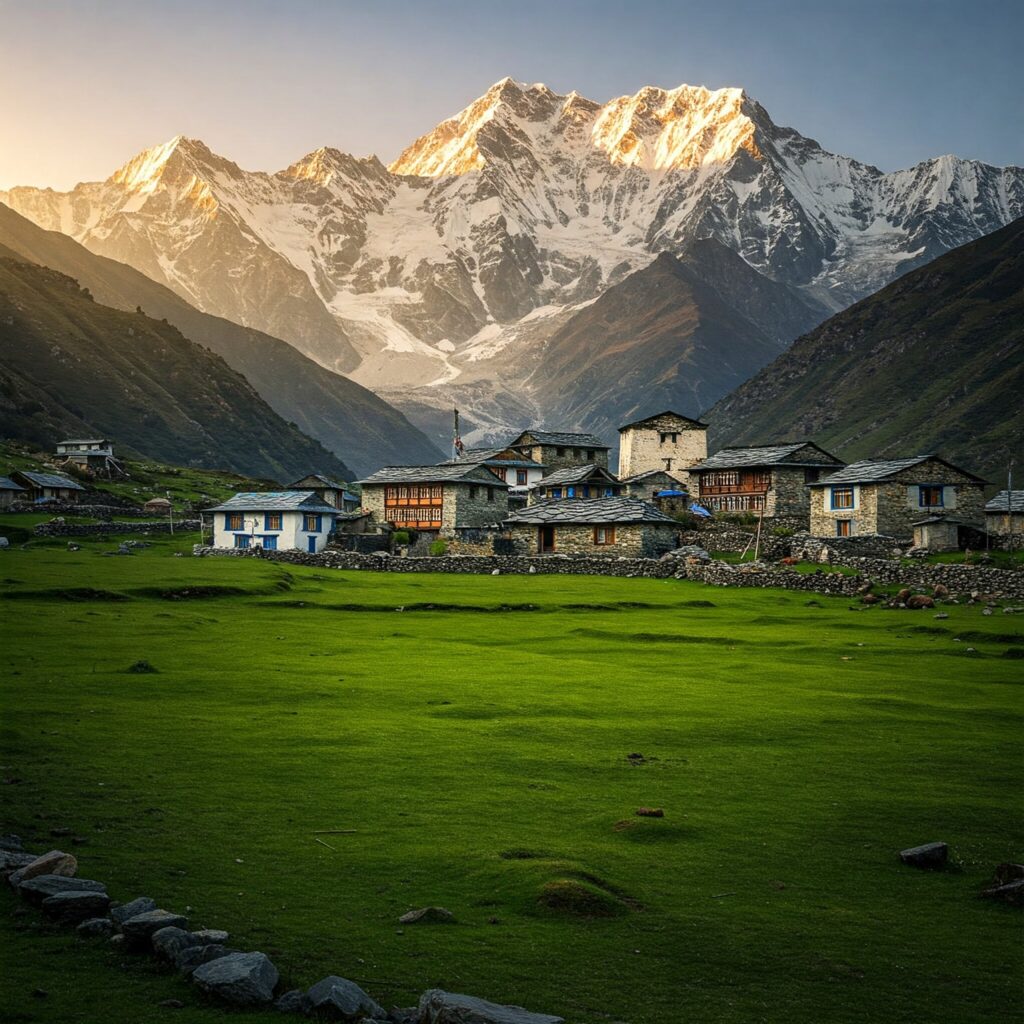
Ascent to Chandrashila Peak: The final leg of the trek, the ascent to Chandrashila Peak, is the most demanding. The trail becomes steeper and rockier, testing your endurance. However, the anticipation of the reward at the summit keeps you motivated. Reaching Chandrashila (4,000 meters or 13,123 feet) is an exhilarating achievement. The breathtaking 360-degree panoramic views from the top are simply unparalleled. On a clear day, you can witness the majestic snow-clad peaks of Nanda Devi, Trishul, Chaukhamba, Kedar Dome, and many others standing tall against the horizon. If you’re fortunate enough to be there for sunrise or sunset, the spectacle is truly magical, as the golden or crimson hues paint the mountainscape in an ethereal glow.
Flora and Fauna: The Chopta Chandrashila trek is also a haven for biodiversity. The lower slopes are adorned with vibrant rhododendron forests that burst into color during spring. You might encounter various species of Himalayan birds, and if you’re lucky, spot wildlife like musk deer or Himalayan tahr. The region is rich in medicinal herbs and diverse plant life, making it a treat for nature enthusiasts.
Difficulty Level: As mentioned earlier, the Chopta Chandrashila trek is generally considered of moderate difficulty. While the initial stretches are relatively easy, the climb to Tungnath and especially the final ascent to Chandrashila require a reasonable level of fitness. For those with less trekking experience, it’s advisable to start with some basic physical preparation, take it slow, stay hydrated, and listen to your body. Hiring a local guide can also enhance your safety and overall experience on this incredible journey, often a key component of a well-organized Chopta tour package from Delhi.
Essential Packing List for Your Himalayan Adventure
Embarking on the Chandrashila summit trek, often a highlight of any Chopta tour package from Delhi, requires careful preparation, and that starts with packing the right gear. Being well-equipped ensures your comfort, safety, and overall enjoyment of this breathtaking journey. Here’s a comprehensive list of essentials to carry:
Clothing: The Layering System is Key
The weather in the Himalayas can be unpredictable, so the layering system is crucial. Start with a comfortable base layer of thermal wear to wick away moisture and keep you warm. The next layer should be insulating, such as a fleece jacket, to trap body heat. Finally, an outer shell consisting of a waterproof and windproof jacket is essential to protect you from rain, snow, and chilly winds. Don’t forget comfortable trekking pants that allow for ease of movement. Pack several pairs of good-quality socks, including wool or synthetic options, to keep your feet dry and prevent blisters. Warm gloves and a hat/cap are vital for protecting your extremities from the cold, especially at higher altitudes and during early mornings or evenings.

Footwear: Your Most Important Investment
Your feet will be doing the hard work, so invest in a pair of sturdy trekking shoes with good ankle support. Ensure they are well broken in before your trek to avoid discomfort. Carrying an extra pair of comfortable shoes or sandals for when you are not trekking will allow your feet to breathe and relax after a long day on the trail.
Backpack: Comfort and Capacity
Choose a backpack that is comfortable to carry and of an appropriate size for a 3-4 day trek (around 40-50 liters). Ensure it has padded shoulder straps and a supportive hip belt to distribute the weight evenly.
Essentials: Your Survival Kit
- Water bottle/hydration pack: Staying hydrated is paramount at high altitudes. Carry at least 2 liters of water capacity.
- Energy bars/snacks: Pack high-energy snacks like nuts, dried fruits, chocolates, and energy bars to keep your energy levels up between meals.
- First-aid kit: A well-stocked first-aid kit is non-negotiable. Include essentials like bandages, antiseptic wipes, pain relievers, blister treatment, and any personal medications.
- Sunscreen: The sun’s rays are intense at higher altitudes, even on cloudy days. Use a high SPF sunscreen to protect your skin.
- Sunglasses: Protect your eyes from the glare of the sun and snow with a good pair of sunglasses.
- Headlamp/torch: Essential for navigating in low light conditions, especially during early morning ascents or in case of delays. Carry extra batteries.
- Trekking pole(s): Trekking poles can significantly reduce strain on your knees and improve balance, especially on steep ascents and descents.
- Personal toiletries: Carry travel-sized toiletries, including toothbrush, toothpaste, soap, and any other personal hygiene items.
- Power bank: Useful for charging your phone and other electronic devices, as charging points may be limited.
Optional but Recommended:
- Camera: To capture the breathtaking beauty of the Himalayas.
- Binoculars: For a closer look at the distant peaks and wildlife.
- Rain cover for backpack: To protect your belongings from unexpected rain.
Packing thoughtfully for your Chandrashila summit trek, often a highlight of a Chopta tour package from Delhi, will contribute significantly to a safe, comfortable, and memorable Himalayan experience. Remember to keep your backpack as light as possible while ensuring you have all the essentials.
Safety Tips and Precautions for Your Himalayan Trek
Embarking on the Tungnath temple trek, often part of a comprehensive Chopta tour package from Delhi, is an exhilarating experience. However, ensuring your safety and well-being is paramount. Here are some essential safety tips and precautions to keep in mind:
Physical Fitness: While the Tungnath temple trek is considered moderate, a basic level of physical fitness is necessary to enjoy the journey comfortably and reduce the risk of injuries. Engage in regular cardiovascular exercises like jogging, swimming, or cycling for a few weeks before your trek. Include some strength training to prepare your legs and core for the ascents and descents.

Altitude Sickness: The trek reaches significant altitudes, making altitude sickness a potential concern. Symptoms can range from mild (headache, nausea, fatigue) to severe (severe headache, vomiting, difficulty breathing). To prevent altitude sickness: * Ascend gradually, allowing your body time to acclimatize. * Stay well-hydrated by drinking plenty of water. * Avoid alcohol and smoking. * Avoid strenuous activity on your arrival day at higher altitudes. * If you experience symptoms, descend to a lower altitude immediately. * Consider consulting your doctor about preventative medication if you have pre-existing conditions.
Trekking Etiquette: Show respect for the environment and local culture. Avoid littering and carry back everything you bring. Be mindful of local customs and traditions. Dress modestly when visiting religious sites. Seek permission before taking photographs of local people. Keep noise levels down, especially in quiet and sacred areas.
Staying Hydrated: Staying hydrated is crucial throughout the trek, especially at higher altitudes. Drink at least 3-4 liters of water per day. Carry sufficient water with you and refill your bottle whenever possible from clean sources. Dehydration can exacerbate altitude sickness and lead to fatigue.
Following the Guide’s Instructions: If you have opted for a guided Chopta tour package from Delhi or hired a local guide, always follow their instructions. They are experienced in navigating the terrain, understanding the weather patterns, and handling emergencies. Their expertise can significantly enhance your safety and overall trekking experience.
Weather Awareness: Mountain weather can change rapidly. Be prepared for changing weather conditions. Pack layers of clothing to adapt to varying temperatures. Check the weather forecast before starting your trek each day and be prepared for rain, wind, and sudden drops in temperature.
Emergency Contact Information: Carry important emergency contact information, including the numbers of your guide, tour operator, and a local emergency contact. Inform someone about your trekking itinerary and expected return time. Consider carrying a satellite communication device in areas with limited mobile network coverage.
By being mindful of these safety tips and taking necessary precautions, you can ensure a safe, enjoyable, and memorable Tungnath temple trek as part of your Chopta tour package from Delhi. Remember that your well-being is the top priority.
Responsible Tourism: Tread Lightly and Connect Deeply
Embarking on the Chopta Chandrashila trek, often facilitated by a convenient Chopta tour package from Delhi, offers a chance to witness the majestic Himalayas. However, this privilege comes with a responsibility – to practice responsible tourism. This ensures the preservation of the pristine environment and the well-being of the local communities for generations to come.

Leave No Trace Principles: Embracing Eco-Friendly Practices
The core of responsible tourism lies in the Leave No Trace Principles. This means minimizing your impact on the natural environment. Pack out everything you pack in, including wrappers, plastic bottles, and any other waste. Stick to marked trails to avoid trampling delicate vegetation and causing soil erosion. Avoid disturbing wildlife or their habitats. Refrain from collecting souvenirs like rocks or plants. When camping, choose designated campsites and minimize your campfire impact by using portable stoves whenever possible. Be mindful of water sources and avoid polluting them. By adhering to these eco-friendly practices, you contribute to preserving the beauty and integrity of the Chopta Chandrashila trek for future adventurers.
Respecting Local Culture: Fostering Meaningful Interactions
Engaging with the local communities is an enriching aspect of the Chopta Chandrashila trek. Respecting local culture involves being mindful of their customs, traditions, and beliefs. Dress modestly, especially when visiting religious sites or interacting with villagers. Seek permission before taking photographs of people. Be polite in your interactions. Learn a few basic local phrases – it goes a long way in building positive connections. Avoid public displays of affection that might be considered inappropriate. Remember that you are a guest in their homeland, and your behavior reflects on all travelers. By interacting respectfully, you can foster genuine connections and gain a deeper understanding of the local way of life.
Supporting Local Businesses: Empowering the Community
One of the most impactful ways to practice responsible tourism during your Chopta tour package from Delhi is by supporting local businesses. Opt for local guides who possess invaluable knowledge of the region’s flora, fauna, and cultural heritage. Choose homestays over large commercial hotels whenever possible, as this directly benefits local families and provides an authentic cultural experience. Dine at local eateries to savor traditional cuisine and contribute to the local economy. Hire local porters for carrying your luggage, providing them with employment opportunities. By consciously choosing local services, you directly contribute to the economic empowerment of the community and ensure that tourism benefits those who call this beautiful region home.
In conclusion, responsible tourism is not just an ethical choice; it’s a way to enhance your travel experience while ensuring the long-term sustainability of the Chopta Chandrashila trek and the well-being of its people. By embracing eco-friendly practices, respecting local culture, and supporting local businesses, you become a conscious traveler, leaving a positive footprint on this precious Himalayan landscape.
Photography and Memories: Immortalizing Your Himalayan Journey
The Chopta Tungnath trek from Delhi, culminating in the breathtaking views from the Tungnath Chandrashila trek, is a feast for the senses and a paradise for photographers. Every bend in the trail unveils a new vista, a captivating scene begging to be captured and cherished. This section encourages you to embrace the photographic opportunities and document your incredible Himalayan adventure.
Capturing the Beauty: A Photographer’s Paradise
From the moment your journey begins in the verdant meadows of Chopta, you’ll be surrounded by unparalleled beauty. The lush meadows, often carpeted with wildflowers in spring, offer stunning wide-angle shots against the backdrop of snow-capped peaks. As you ascend towards Tungnath, the ancient temple perched amidst the dramatic mountainscape presents a unique subject, blending spirituality with natural grandeur. Capture the intricate details of the temple architecture against the vast Himalayan canvas.

The trek to Chandrashila summit offers the most dramatic photographic rewards. The challenging final climb culminates in breathtaking 360-degree panoramic views. Imagine capturing the golden hues of sunrise or the fiery oranges of sunset painting the majestic peaks of Nanda Devi, Trishul, Chaukhamba, and countless others. These are moments that deserve to be immortalized. Don’t forget to capture the smaller details too – the vibrant rhododendron blooms, the intricate patterns on prayer flags fluttering in the wind, the textures of the rocky trails, and the candid smiles of your fellow trekkers.
The diverse flora and fauna along the Tungnath Chandrashila trek also present fantastic photographic opportunities. Keep an eye out for colorful Himalayan birds, unique plant life, and the occasional glimpse of wildlife. Macro shots of wildflowers or close-ups of interesting textures can add another dimension to your visual story. Remember to be patient and observant – some of the most captivating shots are often found in unexpected moments. Consider bringing a good camera with sufficient battery life and storage, and perhaps even a tripod for capturing those stunning sunrise or sunset panoramas.
Sharing Your Experience: Inspiring Others and Reliving Memories
Beyond personal mementos, documenting your Chopta Tungnath trek from Delhi and the subsequent Tungnath Chandrashila trek allows you to share your experience with others. Consider keeping a travel journal, jotting down your thoughts, feelings, and observations along the way. This adds a personal touch to your memories and provides valuable context when you revisit them later.
Embrace the power of photography and videography to visually narrate your journey. Share your stunning images and captivating videos on social media platforms, inspiring friends, family, and fellow travel enthusiasts to embark on their Himalayan adventure. Your documented experience can serve as a valuable resource for others planning their Chopta Tungnath trek from Delhi, providing insights into the trail conditions, the beauty of the region, and the overall experience.
Moreover, revisiting your photographs and journal entries in the years to come will allow you to relive the magic of your Himalayan escape. These visual and written records will serve as cherished reminders of the challenges you overcame, the breathtaking beauty you witnessed, and the profound connection you forged with nature and the mountains. So, pack your camera, open your senses, and get ready to capture the unforgettable moments of your Tungnath Chandrashila trek.
Your Himalayan Adventure Awaits: Embrace the Call of the Mountains
The Chopta Tungnath Chandrashila trek is more than just a journey through the Himalayas; it’s an immersion into a world of breathtaking beauty, spiritual serenity, and personal accomplishment. Let’s take a moment to recap the trek’s highlights that make this adventure so captivating.
From the moment you arrive in Chopta, the “Mini Switzerland,” you are greeted by lush meadows and panoramic vistas that soothe the soul. The trek to Tungnath, the highest Shiva temple, is a spiritual ascent through stunning landscapes, culminating in a visit to an ancient and revered shrine. The final push to Chandrashila Peak rewards your efforts with breathtaking 360-degree views of some of the most majestic Himalayan giants. Along the way, you’ll be enchanted by the region’s diverse flora and fauna, breathing in the crisp mountain air and feeling a profound connection with nature. The moderate difficulty level makes this trek accessible to a wide range of adventurers, offering a satisfying challenge without being overly strenuous.

Now, having journeyed through the highlights of this incredible trek, it’s time for the call to action. If you’re yearning for an escape from the ordinary, a chance to witness unparalleled natural beauty, and an opportunity for introspection amidst the grandeur of the Himalayas, then the Chopta Tungnath Chandrashila trek is calling your name. Plan your adventure, gather your essentials, and prepare to be mesmerized by the magic of this Himalayan gem. Whether you seek spiritual solace, thrilling adventure, or simply a rejuvenating break in nature’s embrace, this trek promises an unforgettable experience. Explore the various Chopta tour packages available from Delhi and choose the one that best suits your needs and preferences. The mountains are waiting to welcome you.
(Optional) Personal Anecdote:
I vividly remember the final ascent to Chandrashila. The air was thin, and each step felt like a small victory. As I finally reached the summit, the sun began to rise, painting the snow-capped peaks in hues of gold and crimson. The sheer scale of the Himalayas unfolding before me, the silence broken only by the gentle wind, created a moment of profound awe and gratitude. It was a feeling of being on top of the world, both literally and figuratively, a memory that will forever be etched in my heart. This trek isn’t just about reaching a destination; it’s about the journey and the transformative experiences along the way.
Don’t just dream about the Himalayas; make it a reality. Your adventure awaits in the captivating embrace of the Chopta Tungnath Chandrashila trek. Take the first step today!
General Trek Information:
- What is the Chopta Tungnath Chandrashila trek famous for? The trek is famous for its stunning lush meadows (Chopta), the highest Shiva temple in the world (Tungnath), and panoramic 360-degree views of the Himalayas from Chandrashila peak.
- What is the difficulty level of the Chopta Tungnath Chandrashila trek? The trek is generally considered of moderate difficulty, suitable for beginners with a reasonable level of fitness and experienced trekkers alike.
- What is the best time to undertake the Chopta Tungnath Chandrashila trek? The best times are spring (March-May) for blooming rhododendrons and pleasant weather, and autumn (September-November) for clear skies and crisp air. Summer (June-August) is also doable but may have occasional rain. Winter is generally not recommended due to heavy snowfall.
- What is the typical duration of the trek, including travel from Delhi? The typical duration is 3-4 days, including travel time to and from Delhi.
Logistics and Planning:
- How do I reach Chopta from Delhi? You can reach Chopta from Delhi by road (self-drive/taxi) or by taking an overnight bus or train to Rishikesh or Haridwar, followed by a taxi or local bus to Chopta.
- Are there any permits or registrations required for the trek? Generally, no specific permits are required for Indian nationals. However, it’s always advisable to check with local authorities for any updated regulations or entry fees for protected areas. Foreign nationals might require permits for certain areas.
- What are the accommodation options available during the trek? Accommodation options in Chopta range from guesthouses and homestays to basic campsites. Near Tungnath, basic accommodations or camping options might be available.
- What kind of food is available during the trek? Basic meals and local cuisine are usually available at guesthouses and small eateries in Chopta and along the route to Tungnath. It’s advisable to carry your own snacks and energy bars.
- Is it advisable to hire a guide or porter for the trek? Hiring a guide is recommended, especially for first-timers or those unfamiliar with the terrain. Porters can be hired to carry your luggage, making the trek easier.
Safety and Health:
- Is altitude sickness a concern on this trek? Yes, altitude sickness can be a concern as the trek reaches altitudes above 12,000 feet. It’s important to ascend gradually, stay hydrated, and be aware of the symptoms.
- What essential items should I pack for the trek? Essential items include layered clothing, sturdy trekking shoes, a comfortable backpack, water bottle/hydration pack, first-aid kit, sunscreen, sunglasses, headlamp, and trekking poles.
- What safety precautions should I take during the trek? Stay physically fit, acclimatize properly, stay hydrated, follow your guide’s instructions, be aware of weather changes, and carry emergency contact information.
Other Important Questions:
- Can this trek be done independently, or is a guided tour recommended? While experienced trekkers can do it independently, a guided tour is highly recommended, especially for beginners, as it ensures safety, provides local knowledge, and handles logistics.
- Are there any ATMs available in Chopta? ATMs are generally not readily available in Chopta. It’s advisable to carry sufficient cash from Delhi or nearby towns like Rishikesh or Ukhimath.
- What are some responsible tourism practices I should follow during the trek? Practice Leave No Trace principles, respect local culture, and support local businesses by opting for local guides, homestays, and eateries.
Recent Posts
Chakrata in Winters
Madmaheshwar Trek Difficulty & Beginner’s Complete Guide
Chopta in Winters
Tags

Thailand


